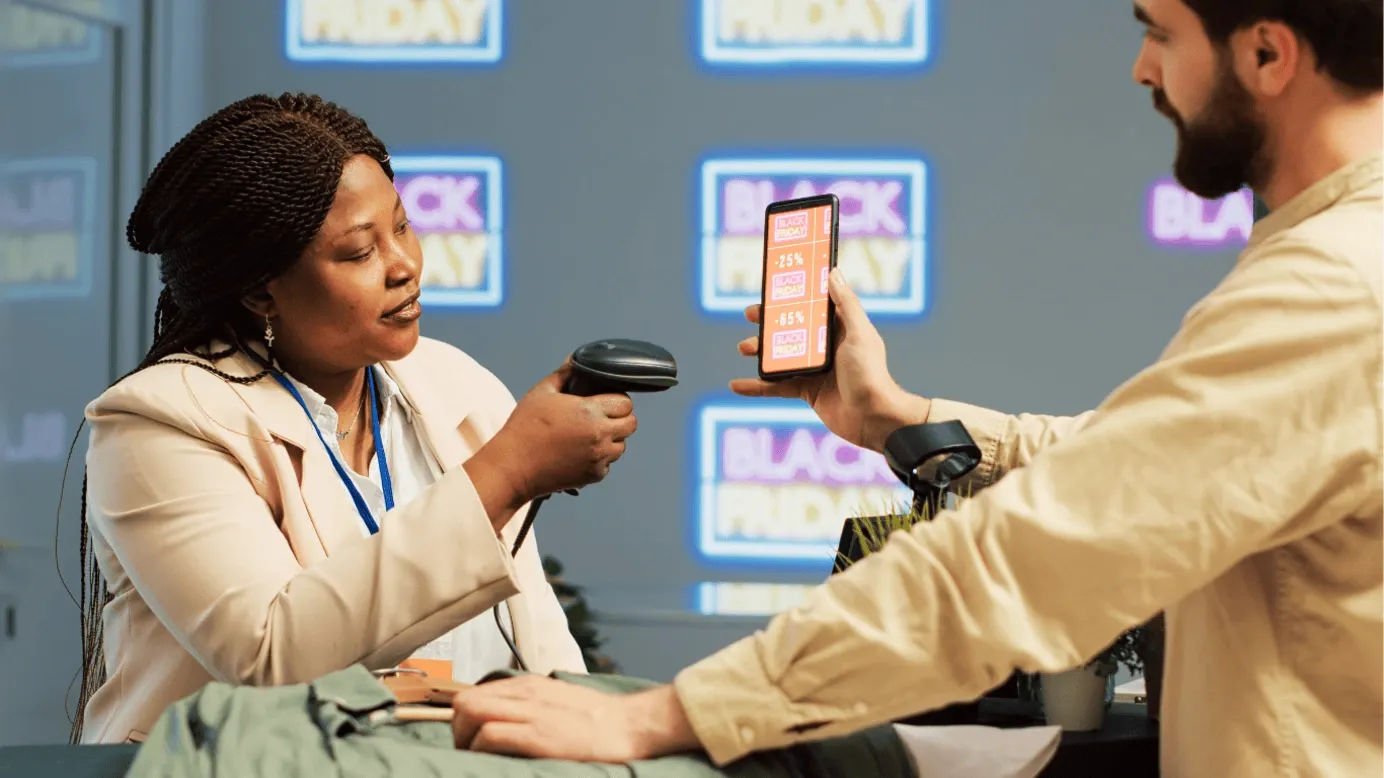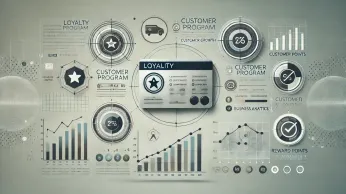Top 10 Customer Loyalty Program Examples: Driving Engagement and Retention
Discover inspiring loyalty program examples from industry leaders. See how innovative rewards and tailored experiences build customer loyalty and drive business success.
On this page
What do American Airlines, Amazon Prime, and Mastercard have in common? Beyond their dominance in their respective industries, they all have exceptional loyalty programs driving customer engagement and participation. These initiatives stand out as some of the most successful loyalty program examples, sparking repeat business globally.
Take Amazon Prime, for instance. According to NBC News, "Prime is Amazon’s paid loyalty program." Beyond exclusive savings events, Prime offers fast, free shipping, grocery delivery, and perks like Grubhub+ memberships. These benefits not only attract new members but also encourage renewals year after year.
Harvard Business Review highlights the "sunk cost" theory, which suggests customers feel compelled to use what they’ve invested in. Supporting this, Forbes notes that 46% of consumers are willing to pay more for brands with strong rewards programs, while 61% stick to brands offering valuable incentives.
Loyalty programs reward customers with points, discounts, or exclusive perks to encourage repeat purchases. From point-based systems to cash-back offers, businesses can customize their programs to create engaging, tailored experiences that build long-lasting loyalty.
5 Innovative customer loyalty program examples
Listed are five loyalty program examples that companies can give a try for better customer loyalty.
1. Personalization through AI
Artificial intelligence (AI) integration has completely changed how companies interact with their clients. This strategy surpasses the one-size-fits-all model by providing customized experiences that profoundly align with personal preferences and actions.
Customized recommendations based on purchase history: AI-driven loyalty programs are known for their ability to offer personalized suggestions based on a user's past purchases. AI systems can anticipate future preferences with high accuracy by evaluating transaction data and past interactions. This allows businesses to provide tailored product recommendations that improve consumer satisfaction.
Tailored rewards and offers for individual customers: AI-powered loyalty programs also excel at providing customized offers and prizes to each unique consumer. These incentives, which can include special discounts on regularly purchased goods or personalized offers on related goods, are made to personally connect with each consumer and establish a feeling of worth and appreciation.
Real-time engagement through AI chatbots: These advanced virtual assistants, enabled by AI chatbots, are open to respond to consumer questions, provide product recommendations, and even offer real-time shopping assistance. Businesses can streamline the whole shopping experience while increasing consumer engagement and loyalty by providing smooth, personalized help at every touchpoint.
2. Augmented Reality (AR) integration
Integrating augmented reality (AR) is another loyalty program example to engage customers by creating immersive experiences that smoothly combine the digital and real worlds.
Virtual try-ons for products: Customers can virtually try on products before purchasing augmented reality technology, which improves online shopping and reduces the need for physical stores. Customers can see how items appear on themselves in real time when trying on clothing, makeup, or sunglasses, which encourages more assured buying decisions and fewer returns.
AR-Based treasure hunts or games for rewards: Gamification and excitement are added to loyalty programmer using augmented reality-based treasure hunts and games. Customers can take part in interactive games and treasure hunts where they have to find virtual or real-world prizes hidden in various locations. In addition to encouraging participation, this increases visits to physical venues and gives participants a sense of excitement and fun.
3. Social media loyalty programs
Social media loyalty programs make use of digital platforms' potential to interact and engage customers in new and interesting ways that promote brand promotion and loyalty.
Exclusive contests or challenges on social platforms: On social media, brands host unique competitions or challenges and invite consumers to take part to win prizes. User-generated content, such as photo or video entries, may be allowed in these competitions, enabling participants to express their unique perspectives and brand loyalty. Brands build relationships with their social media followers and encourage involvement by rewarding participation with tempting rewards and unique experiences.
Influencer partnerships for enhanced engagement: By working together with influencers on social media, brands may expand their reach and encourage interaction among their followers. Influencers showcase products, promotions, and special deals to their devoted follower base while sharing their real-life experiences with the company. Utilizing strategic alliances with influencers whose values coincide with the brand, companies can expand their consumer base, establish trust, and foster a devoted following.
4. Subscription-based loyalty models
Another loyalty program example is the subscription-based loyalty program. Customers receive special advantages and access to premium content or services, offering an organized approach to client engagement.
Membership tiers with increasing benefits: Brands offer multiple membership tiers, each with its own set of benefits and rewards. Customers can receive additional benefits, including discounts, tailored suggestions, first access to events or products, and committed customer service as they advance through higher stages. Brands foster ongoing engagement and loyalty by rewarding members who move up the tiers with exclusive advantages, all while recognizing their most loyal customers.
Access to premium content or services through subscriptions: By offering valuable content or services through subscriptions, brands enhance the perceived value of membership and provide additional incentives for customers to join and stay loyal to the program. Premium content or services that members can access that are not available to non-members are exclusive video content, digital publications, virtual events, or premium features within an app or platform.
5. Eco-Friendly Loyalty Programs
Another innovative loyalty program example of environmentally conscious customer behavior is to be rewarded and encouraged by eco-friendly loyalty programs.
Rewards for eco-conscious purchases: Rewards or points are given by brands to consumers who make environmentally conscious purchases, such as selecting sustainable goods, recycling used goods, or using eco-friendly packaging. These benefits can be in the form of bonus points, savings on subsequent purchases, or special access to eco-friendly products. Brands encourage customers to make environmentally conscious decisions while cultivating customer loyalty and engagement by offering incentives for sustainable buying practices.
Sustainable packaging options with bonus points: or their orders, customers can select environmentally friendly packing options like recyclable or biodegradable materials. Customers who choose these environmentally friendly solutions receive bonus points or incentives in their loyalty accounts. This minimizes the negative effects of packaging waste on the environment and encourages consumers to become involved in sustainability projects.
6 Companies with successful loyalty program examples
Loyalty programs have become a vital tool for businesses to engage customers, encourage repeat purchases, and drive revenue growth. Here, we explore five outstanding loyalty program examples from industry leaders who have set new benchmarks in customer retention and satisfaction.
1. Marriott Bonvoy: Loyalty program example in the hospitality industry
Marriott International provides Marriott Bonvoy, with a comprehensive reward program that spans a global network of more than 7,000 hotels. Members can take advantage of several perks, such as complimentary nights, hotel upgrades, and special events.
Points system and rewards for stays at Marriott hotels: Higher tier members receive bonus points, and members receive points for every dollar spent on eligible stays. Redeeming points can get you free nights, hotel upgrades, events, and much more.
Membership tiers and personalized experiences: There are several membership tiers available with Marriott Bonvoy, including Silver, Gold, Platinum, Titanium, and Ambassador. With each grade comes ever greater value privileges like lounge access, late checkout, and personalized service from an ambassador.
Revenue/Growth: With 200 million hotel loyalty members, Marriott Bonvoy accounts for 35% of gross fee income, with the top 1% of members contributing the most. The program's revenue is significantly boosted by these highly engaged consumers, many of whom use the mobile app, own co-branded credit cards, and participate in other activities such using Homes and Villas by Marriott Bonvoy.
Marriott uses the revenue from its loyalty program as a key performance indicator to assess the financial effects of its large membership base and engagement tactics.
2. Sephora Beauty Insider: Loyalty program example in the retail industry
Leading beauty shop, Sephora offers a variety of skincare, cosmetics, and fragrance goods, as well as a loyalty program named Sephora Beauty Insider. It provides members with several benefits, including birthday presents, points for purchases, and special access to events.
Tiered membership levels with increasing benefits: Insider, VIB (Very Important Beauty Insider), and Rouge are the three tiers that Beauty Insider offers; each has superior benefits and incentives. With every dollar spent, members accrue points that can be exchanged for goods, freebies, or activities.
Personalized recommendations and exclusive offers: Sephora presents personalized product recommendations based on a member's preferences and past purchases. Birthday presents, early access to new items, and invitations to VIP parties are examples of exclusive offers.
Revenue/Growth: The Sephora Beauty Insider program has helped the company's sales rise significantly, with over 25 million members. They got over 80% of sales from members of its loyalty program, which resulted in a 25% rise in revenue over the previous year.
3. Delta SkyMiles: Loyalty program example in the airline industry
One of the biggest airlines in the world, Delta Air Lines, has a loyalty program identified as Delta SkyMiles. It provides members with a number of advantages, such as upgrades, priority boarding, lounge access, and miles for travel.
Earning miles and redemption options: Miles can be accrued by members for travel, Delta Vacations packages, and qualifying partner transactions. The redemption of miles can be used to purchase flights and seat preferences.
Exclusive perks for members, such as priority boarding and lounge access: Members of Delta SkyMiles are entitled to free upgrades, priority boarding, and access to Delta Sky Club lounges.
Revenue/Growth: The airline reported that during the third quarter of 2023, the most miles redeemed for award travel in the program's history showed the program's ongoing strength.
At an average revenue per passenger of $32.10, Delta's loyalty program generated $5.5 billion in revenue, placing it second globally after American Airlines.
4. Chase Bank - Loyalty program example in the banking industry
Travel, gift cards, and cashback are just a few of the redemption options that Chase Bank offers its cardholders. It provides bonus spending categories, sign-up bonuses, and transferable points to Chase's hotel and airline partners.
Earning points through credit card spending and redemption options: Every dollar that is spent on eligible purchases made with Chase credit cards earns points for the cardholder. Points can be transferred to Chase's hotel and airline partners or redeemed for gift cards, travel, and statement credits.
Unique features like sign-up bonuses and transferable points: In addition to facilitating point transfers across Chase cards and to Chase's airline and hotel partners, Chase provides sign-up bonuses to new members.
Revenue/Growth: Chase disclosed a $330 million charge in the second quarter of 2018 for engaged customers who used their Ultimate Rewards points faster than anticipated. This suggests that the program is generating a lot of engagement and redemptions from loyal customers.
5. NikePlus- Loyalty program example in the sports industry
Nike is a popular sportswear and athletic shoe brand worldwide. Members can take advantage of early access to releases, member-only items, and customized training plans, among other features.
Member-exclusive products and early access to releases: Members of NikePlus have access to member-only events, early access to limited-edition releases, and unique products. In addition, they get customized training plans and product recommendations based on their fitness objectives.
Personalized training programs and rewards for fitness goals: Nike Plus provides individualized training plans based on the interests and fitness objectives of each member. Members have access to goal-setting tools, progress monitoring, and professional advice from Nike.
Nike also gives its members rewards for hitting fitness benchmarks, such as finishing a predetermined amount of workouts or hitting a predetermined distance target. Discounts on Nike clothing, admission to VIP events, and special products are some examples of rewards.
Revenue/Growth: With the Nike app and SNKR app currently available in over 20 countries and exceeding other channels, contributing to 38% digital growth in Q2, the NikePlus program has been a key factor in Nike's total digital development.
6. Riyadh’s leading retail chain- Loyalty program example in the retail industry
A top retail chain in Riyadh partnered with Loyalife's Loyalty Business Management System (LBMS) to revamp its customer engagement strategy. Their goal was to boost customer retention and increase mobile app adoption. By implementing a personalized loyalty program, the retail giant introduced a dynamic system where customers could earn points for every purchase, receive tailored rewards, and enjoy exclusive member benefits.
Boosting engagement and retention: The retail chain aimed to create a loyalty program that went beyond basic rewards. They wanted to engage customers at every touchpoint, encourage repeat purchases, and drive more users to their mobile app.
Personalized and omnichannel approach: The program focused on omnichannel engagement, allowing customers to earn and redeem points both in-store and through the mobile app. Through personalized promotions and targeted campaigns, the brand kept customers actively engaged, encouraging repeat purchases. Additionally, Loyalife’s flexible accrual engine allowed the business to create specific incentives tied to customer behaviors, such as bonus points for high-value purchases or referrals.
Impressive growth and impact: The results were impressive: the retail chain saw a 133% annual increase in active loyalty program users and over 40,000 new app downloads in just one year. This loyalty strategy not only boosted customer engagement but also significantly contributed to revenue growth, proving the effectiveness of a well-designed, personalized loyalty program powered by Loyalife.
Loyalife: Redefining loyalty programs in 2025
Loyalife offers an all-in-one platform to design, manage, and scale impactful customer loyalty programs. With a scalable loyalty engine, personalized multichannel campaigns, and AI-powered analytics, Loyalife enables businesses to create tailored experiences that foster customer engagement.
Seamless API integration ensures smooth connectivity with CRMs, marketing tools, and transaction systems, while fraud management features and multi-language support cater to global audiences. Delivering an omnichannel experience, Loyalife transforms loyalty programs into powerful tools for growth.
Partner with Loyalife today and unlock the full potential of customer loyalty!
Conclusion
These excellent loyalty programs from Nike, Marriott, Sephora, Delta, and Chase demonstrate the value of building relationships with customers. These companies with loyalty programs raise the bar for loyalty program success in the current industry by fostering long-term client loyalty and driving revenue growth through personalized experiences and rewards.
FAQ's
1. What are some successful loyalty program examples?
Successful loyalty programs include Starbucks Rewards, Amazon Prime, and Sephora’s Beauty Insider. These programs use points, perks, and personalized experiences to engage customers and encourage repeat purchases.
2. Can you provide examples of loyalty schemes?
Examples of loyalty schemes include tiered programs like Emirates Skywards, cashback programs such as Rakuten, and subscription-based models like Costco Membership, which provide exclusive benefits for a fixed fee.
3. What are some customer loyalty program examples in retail?
Popular examples of customer loyalty programs in retail are Target Circle, which offers discounts and rewards, and Nordstrom’s The Nordy Club, providing points, early access, and exclusive offers.
4. What loyalty programs examples exist for restaurants?
Examples of restaurant loyalty programs include McDonald’s MyMcDonald’s Rewards and Chipotle Rewards, which let customers earn points for free meals and exclusive perks.
5. What are the most common types of loyalty programs?
Common types include point-based systems (like Dunkin’ Rewards), tiered programs (like Marriott Bonvoy), and hybrid schemes combining multiple features, as seen in Hilton Honors.








